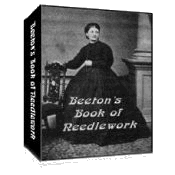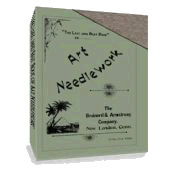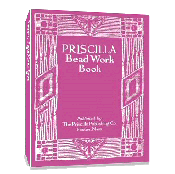Linen Embroidery

Click on image to see more detail.
The definition of Linen Embroidery is ... well... it depends on who you talk to or who's book you read. When I started researching this type of embroidery, I found a good resource and thought that was the answer. But as usual, I check against other references and that is when I found that there are many definitions of this embroidery.
I decided to include two different sources here. The first is from Encyclopedia of Needlework, by Therese De Dillmont (1884). The second is from Dictionary of Needlework: Encyclopedia of Artistic, Plain, and Fancy Needlework by SFA Caulfeild and Blanche C. Saward (1882).
Linen Embroidery
Encyclopedia of Needlework, by Therese De Dillmont, edited
The stitches used in linen embroidery are very similar to those used in canvas work. The ordinary cross stitch is the one most commonly used, but it is not so
effective as the two-sided stitches, which in the beautiful old needlework of the 15th, 16th and 17th centuries, have always excited our wonder and admiration.
STUFFS SUITABLE FOR THIS EMBROIDERY.--Most embroidery of this kind, and more especially the Italian, is done on very fine linen. Such fine work however, requires more time and patience than people, in these days, are as a rule disposed to bestow on work intended merely for pleasure and recreation.
To meet the requirements of the day, therefore, in addition to the finer kinds of linen, a great variety of textures, are now manufactured, the threads of which, being thick and round, can be easily counted. The cross stitches that are worked on Cuba, Ceylon or Batavia linen, are large and coarse, those on linen-canvas, Russian linen, twisted tammy, and Rhodes linen, small and fine.
Linen fabrics are either white, unbleached or cream-coloured. All three
are used for embroidery, but the coloured cottons show up best on the
cream ground; on the white, they look hard and crude, and on the
unbleached, dull and faded.
The picture (from Dillmont's book) at the top of the page is described as Embroidery on Linen worked with DMC flax or flourishing thread.
Linen Embroidery
Dictionary of Needlework: Encyclopedia of Artistic, Plain, and Fancy Needlework by SFA Caulfeild and Blanche C. Saward
Linen Embroidery was a description of Embroidery well known in Continental Europe during the 18th century, particularly in Germany, where it was used to decorate the borders of towels, tablecloths, and counterpanes because it had the merit of looking well upon both sides. It partakes both of the nature of Drawn Work and Embroidery and is in extremely good taste, besides wearing well, and being of handsome appearance.
It is made by tracing upon good hand-made Linen a bold conventional outline, drawing away the Linen Threads at stated intervals, and Overcasting those left, so as to form a ground composed of open squares, while the plain Linen within the traced outline is Buttonholed round and forms the design.

Fig. 1.
Click on image to see more detail.
To work as shown in Fig. 1: This pattern is taken from an old German piece of work, and is executed upon good, but not too fine, Linen, with red washing silk, or Turkey red ingrain cotton.
Transfer the pattern to the Linen by means of tracing paper and carbonized paper, and back the Linen with parchment or toile ciré. Then BUTTONHOLE all round the outline with the red silk, and make the Buttonhole lines very narrow.
Draw out the upright threads of the material in sections, pull out six or eight threads, and leave two, and repeat to the end of the linen, but cut the drawn threads where they touch the thick parts of the pattern.
Having finished the upright lines, draw out the horizontal ones in the same manner, so that a network of squares is formed upon the ground. Thread a needle with silk, and OVERCAST over all the left threads.
The difficulty in the work will be in the even Overcasting of these lines; they should be steadied by being held down by the left thumb, and the silk used in the Overcasting should be selected without blemishes or rough places.
Two more examples of Linen embroidery

Hungarian Linen Embroidery
Click on image to see more detail.

German Linen Embroidery
Click on image to see more detail.
Another kind of Linen Embroidery
In this, the work and background are quite solid, lines of Drawn threads being used only to form ornamental borders.
To work: Trace a bold conventional flower pattern upon Russian Crash, or coarse white linen. Work the outlines of the same in CREWEL STITCH, with blue linen thread, and work the fillings with SATIN, FEATHER, CORAL, CROSS STITCH, and FRENCH KNOTS. Alter the direction of the stitches, and the stitches in various parts of the work, and thus produce a variety of effects from the same design.
An imitation of this Linen Embroidery is made upon Java canvas, and is used for cushions, mats, and other articles; the threads of the Java canvas not being drawn away, the ground of the Embroidery is solid.
To work: Trace the design as before mentioned, then take coarse silk, and RUN it along the squares of the canvas, making one stitch answer to one side of a square. Run all the upright and horizontal lines in this manner, and so form a groundwork of squares. Then take fine silk, of the same color as used on the ground, and OVERCAST all the lines of the design.
Another variation of imitation Linen Embroidery is to cut out the pattern upon linen, lay that upon the java canvas, OVERCAST it down, and then RUN the lines upon the groundwork.
Neither of these imitation Linen Embroideries can be used upon the wrong side like the real Linen Embroidery.
Return to top of Linen Embroidery page.
Return to Types of Embroidery page.
The Last and Best Book of Art Needlework
Over 100 pages of authentic Victorian instructions and patterns from 1895!
FREE
Beeton's Book Of Needlework

433 pages!
Sign up for VEAC! Everything you wanted to know about Victorian embroidery, needlework, crafts and more!
Priscilla Bead Work Book
Make Beautiful Victorian Beaded Purses, Jewelry & Accessories - Starting
TODAY!



